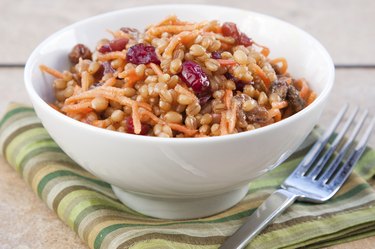
Wheat is the most widely consumed grain in America according to the U.S. Department of Agriculture. Wheat berries are whole, unprocessed wheat kernels in their most natural form. Wheat berries resemble other hearty whole grains, such as barley. They are extremely nutritious and offer a crunchy texture. Wheat berries offer all of the nutrients of a whole grain as they contain the germ, endosperm and bran. All wheat products, such as wheat flour, are made from wheat berries. With their exceptional nutrient content and crunchy texture, they are a tasty food choice on their own.
Varieties
Video of the Day
Wheat berries are not all alike and, in fact, there are several types that vary in texture, color and size. They are usually named after their growing season, gluten content and color. They are grown in winter or spring, may be hard versus soft wheat and red or white. Those most readily available in health food stores and some supermarkets include hard red spring and winter wheat berries, which are very chewy, high in protein and brownish-colored. These varieties are usually used to make "rough" flour and breads. Soft white wheat berries, on the other hand, are starchy, have a softer kernel and may be used to make pastry flour, according to the Nourish Network website.
Video of the Day
Basic Nutrient Values
Regardless of the variety, wheat berries are high in carbohydrates and dietary fiber, as well as vitamins and minerals. Protein content varies somewhat. A normal serving of wheat berries is 1/4 cup dry which, when cooked, yields 1/2-cup serving. A 50 gram serving of hard red wheat berries, or about 1/4 cup uncooked, provides 163.5 calories, 1 gram of fat, 6.5 gram of protein, 35.5 gram of carbohydrates, 6 gram of dietary fiber and 1 milligram of sodium. Wheat berries are rich in vitamins B1 and B3; and the minerals magnesium, phosphorus, copper, manganese and selenium.
Significance of Wheat Berry Micronutrients
B vitamins are important for a healthy nervous system and energy metabolism; magnesium along with phosphorus is essential for regulating blood pressure and building strong, healthy bones. Phosphorus is also needed to form part of DNA and RNA, activate some proteins in the body and store and transport energy. Copper is needed to form connective tissue, blood cells and promote function of the nervous, immune and cardiovascular systems. Manganese aids in bone formation and the metabolism of carbohydrates and proteins while selenium supports immune system and thyroid gland function.
Health Benefits
Wheat berries, like most whole grains, are an excellent source of dietary fiber -- which promotes digestive health; helps lower blood cholesterol and blood sugar levels; aids in weight management and encourages regular bowel movements. The Harvard School of Public Health reports that whole grains, such as wheat berries, contain plant estrogens or phytoestrogens that may reduce your risk of developing certain types of cancers -- particularly in conjunction with minerals found in whole wheat -- such as magnesium, selenium, copper, and manganese.
Adding to Your Diet
Wheat berries may be sprouted, which makes them sweeter; cracked and added to salads; cooked as a grain or side dish; and/or ground into a flour to be used in breads or other baked goods. Hard wheat berries take longer to cook than soft and may need to be soaked in water overnight. If you are adding them to a salad, allowing the dish to stand overnight in the refrigerator enables the berries to absorb flavor from the other ingredients. Try mixing wheat berries with rice and/or other whole grains to make a pilaf. Use them in soups or stews or as a replacement for croutons on your salad.